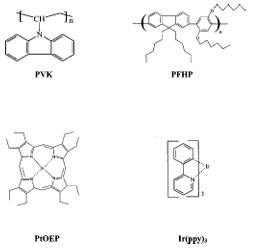Energy transfer and device performance in phosphorescent dye doped polymer light emitting diodes
- 저자
- Yong-Young Noh, Chang-Lyoul Lee, Jang-Joo Kim and Kiyoshi Yase
- 저널명
- The Journal of Chemical Physics, 118, 2853–2864 (2003)
- 년도
- 2003
- Link
- https://doi.org/10.1063/1.1535211 309회 연결
[Abstract]
Singlet and triplet±triplet energy transfer in phosphorescent dye doped polymer light emitting devices were investigated. Poly(N-vinylcarbazol) and poly@9,98-di-n-hexyl-2,7-¯uorene-alt1,4-(2,5-di-n-hexyloxy)phenylene] ~PFHP! were selected as the host polymer for the phosphorescent dopants fac-tris~2-phenylpyridine! iridium~III! @Ir(ppy)3# and 2,3,7,8,12,13, 17,18-octaethyl-21H,23H-porphyrin platinum~II!~PtOEP! because of their high triplet energy levels and long phosphorescence lifetimes. In case of PVK ®lm, ef®cient triplet energy transfers to both PtOEP and Ir(ppy)3 were observed. In contrast, the triplet energy transfer did not occur or was very weak from PFHPto both PtOEPand Ir(ppy)3 although usual requirements for triplet energy transfer were satis®ed. Furthermore, the singlet±singlet energy transfer did not take place from PFHP to Ir(ppy)3 in doped ®lms even though the Fo Èrster radius is more than 30 Å. However, the blended ®lm of Ir(ppy)3 with PFHP and PMMA showed the green emission from Ir(ppy)3 via singlet energy transfer. In addition, the solution of PFHP and Ir(ppy)3 ~8 wt.%! in p-xylene also showed green emission. The blocking of the energy transfers in the phosphorescent dye doped PFHP ®lms is found to be originated from the formation of aggregates which is evident from the microscopic images taken by transmission electron microscope, atomic force microscope, and ¯uorescence microscope. The formation of aggregates prevents dopant molecules from being in close proximity with host molecules thereby inhibiting energy transfer processes. The phase separation deteriorates the device performance also. Therefore, the chemical compatibility of a dopant with a host polymer as well as conventional requirements for energy transfers must be signi®cantly considered to fabricate ef®cient phosphorescent dye doped polymer light emitting devices.
Singlet and triplet±triplet energy transfer in phosphorescent dye doped polymer light emitting devices were investigated. Poly(N-vinylcarbazol) and poly@9,98-di-n-hexyl-2,7-¯uorene-alt1,4-(2,5-di-n-hexyloxy)phenylene] ~PFHP! were selected as the host polymer for the phosphorescent dopants fac-tris~2-phenylpyridine! iridium~III! @Ir(ppy)3# and 2,3,7,8,12,13, 17,18-octaethyl-21H,23H-porphyrin platinum~II!~PtOEP! because of their high triplet energy levels and long phosphorescence lifetimes. In case of PVK ®lm, ef®cient triplet energy transfers to both PtOEP and Ir(ppy)3 were observed. In contrast, the triplet energy transfer did not occur or was very weak from PFHPto both PtOEPand Ir(ppy)3 although usual requirements for triplet energy transfer were satis®ed. Furthermore, the singlet±singlet energy transfer did not take place from PFHP to Ir(ppy)3 in doped ®lms even though the Fo Èrster radius is more than 30 Å. However, the blended ®lm of Ir(ppy)3 with PFHP and PMMA showed the green emission from Ir(ppy)3 via singlet energy transfer. In addition, the solution of PFHP and Ir(ppy)3 ~8 wt.%! in p-xylene also showed green emission. The blocking of the energy transfers in the phosphorescent dye doped PFHP ®lms is found to be originated from the formation of aggregates which is evident from the microscopic images taken by transmission electron microscope, atomic force microscope, and ¯uorescence microscope. The formation of aggregates prevents dopant molecules from being in close proximity with host molecules thereby inhibiting energy transfer processes. The phase separation deteriorates the device performance also. Therefore, the chemical compatibility of a dopant with a host polymer as well as conventional requirements for energy transfers must be signi®cantly considered to fabricate ef®cient phosphorescent dye doped polymer light emitting devices.
